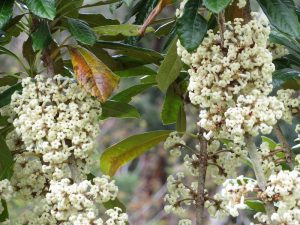
“Everyone craves a connection to the land,” says Michael Gibson, owner of Elemental Plants Nursery in Honoka’a. “Caring for and cultivating native plants restores and strengthens that connection.” Elemental Plants sits at the top of the Hamakua Farm Hub, at the corner of Hawaii Belt Road and Mamane Street. Outside of pandemic times, Sunday visitors can enjoy a bustling farmer’s market with live music, vendors, and educational demonstrations. This collaborative community effort brings together local experts, agricultural producers, craft sellers, and community members to promote a healthy rural lifestyle and a robust local economy. Gibson’s nursery, overflowing with color and life, draws people in to browse.
Gibson has provided native and non-invasive plants on Hawaii Island for many years. “Growing native plants is more than being eco-chic. It’s throwing a lifeline to the native species that depend on each other for food and habitat. Native plants and animals evolved together,” he explains. “It’s a cyclical relationship; you can’t have one without the other.” The ʻalalā and hōʻawa are a prime example of this relationship. One hundred years ago both were common across the island, and hōʻawa fruits were a favorite food for the ʻalalā, the native Hawaiian crow. In turn, the crow spread the seeds far and wide. But the development of their habitat and encroachment by invasive species put immense pressure on the tree and the bird until hōʻawa populations plummeted and ʻalalā were so few that they became extinct in the wild.

However, as captive-bred ʻalalā are slowly being returned to the wild, residents of Hawai’i Island have an opportunity to build a brighter future for this intertwined pair. Hōʻawa are attractive, small trees with sweet-smelling flowers – making them a perfect backyard addition! Hōʻawa trees planted today could provide sustenance for the endangered ʻalalā in a decade or two, helping the native bird reclaim its home. Want to bring this element of hope to your backyard? You can get your own hōʻawa at Elemental Plants! They offer over 35 native plants, along with the expertise to ensure a successful planting. Gibson knows which plants will suit his customers’ needs and what will grow well in their landscape. Years of trial and error have taught him what works and what doesn’t in various conditions.
Gibson invites the public to stroll through the demonstration garden and orchard to observe how the plants look and behave. The inventory extends beyond natives: fruit trees are another popular item at Elemental Plants. Growing and sharing locally grown food is a treasured activity on the Big Island – and important to our food security. “We import 85% of our food in Hawaii. If the supply chain gets disrupted, things will get bad, fast,” explains Michael. “Residents should take advantage of Hawaii’s year-round growing season. The best time to grow food today.”
Grocery stores only have 4 to 5 days worth of food at any time. In the WWII Victory Garden era, everyday citizens grew 40% of the nation’s produce at home. Here in Hawaii, our mild climate, volcanic soils, and extensive pool of expertise provide even the most novice gardener an opportunity to follow their example and provide for family and neighbors with fresh produce from our own yards. Again, Gibson can recommend the right fruit tree for your climate.

Don’t have extensive outdoor space? Don’t fret! Across the globe, indoor gardening has become a botanical craze. Interior landscaping is a quick way to liven up one’s home and create a warm, inviting atmosphere. Plants naturally clean indoor toxins, and many plants thrive indoors with bright, indirect light. Gibson provides the right plants, along with the right advice. Growing inside can be tricky: for example, succulents, while very popular, actually don’t do all that well inside. They need too much light. On the other hand, money trees, begonias, and peperomias can all thrive in the indoor environment.
Whether it’s a native plant, a food plant, or an indoor plant, you will never have to worry about purchasing a potentially invasive species from Elemental Plants. As a Plant Pono-endorsed business, Elemental Plants has voluntarily agreed not to sell invasive plants. Despite the well-known adverse impacts on Hawaii’s agriculture and environment due to out-of-control introductions, there is surprisingly little regulation to prohibit the sale of invasive plants in Hawaii. Plant Pono nurseries agree to go above and beyond the law, and take personal responsibility for selecting only non-invasive plants to grow and sell. They also follow best management practices to control pests like little fire ant (LFA) and coqui.
“I survey all incoming plants for LFA. And I keep peanut butter in my truck,” says Gibson. Because he lives where he works and has a deep connection with his community, he is committed to ensuring his plants are pest-free. LFA look like tiny pieces of orange dirt, so they can be very difficult to detect. Due to their small size and excellent camouflage, potted plants a common vehicle for unknowingly moving them around. Using a stick with peanut butter is a very cheap, easy, and efficient way to find LFA before they can spread.
Elemental Plants is one of a network of Pono businesses on the Big Island that is partnering with BIISC to prevent the spread of invasive species, and we appreciate everyone! You can contact them for at (808) 640-2506 or by email michaelgibson111@gmail.com. They are open on reduced hours Sundays 9 to 1 and Thursdays 10 to 4. For more information about the Plant Pono program, contact Plant Pono specialist Molly Murphy at mollym3@hawaii.edu.



